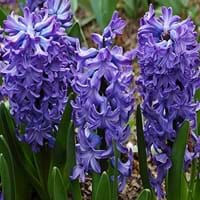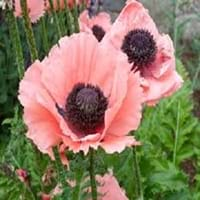Life Span
Perennial
Perennial
Type
Bulb or Corm or Tuber
Tender Perennial
Origin
Mediterranean, Western Asia
Western Asia
Types
Not Available
Not Available
Habitat
Mediterranean region
Lake margins, Lake Sides, Temperate Regions
USDA Hardiness Zone
4-9
3-9
Sunset Zone
21,22
A1, A2, A3, 1a, 1b, 2a, 2b, 3a, 3b, 4, 5, 6, 7, 8, 9, 10, 11, 14, 15, 16, 17, 18, 19, 20, 21
Habit
Clump-Forming
Upright/Erect
Flower Color
White, Yellow, Red, Blue, Purple, Pink, Lavender, Violet
Light Pink
Flower Color Modifier
Bicolor
Bicolor
Fruit Color
Not Available
Not Available
Leaf Color in Spring
Green
Green, Gray Green, Dark Green
Leaf Color in Summer
Light Green
Not Available
Leaf Color in Fall
Several shades of Green
Green, Gray Green, Dark Green
Leaf Color in Winter
Light Green
Not Available
Leaf Shape
Long slender
Aristate
Plant Season
Spring, Winter
Spring, Summer
Sunlight
Full Sun, Partial Sun
Full Sun, Partial Sun
Growth Rate
Medium
Medium
The pH of Soil
Acidic, Neutral
Acidic, Neutral, Alkaline
Soil Drainage
Well drained
Well drained
Bloom Time
Early Spring, Spring, Late Winter, Indeterminate
Late Spring, Early Summer
Tolerances
Black Walnut Toxicity, Rabbit, Shade areas
Not Available
Where to Plant?
Container, Ground, Pot
Container, Ground, Pot
How to Plant?
chipping, Offsets, scooping, Twin scaling, Vegetative
root cutting
Plant Maintenance
Low
Medium
Watering Requirements
Medium
Keep the Soil well drained
In Summer
Lots of watering
Lots of watering
In Spring
Moderate
Moderate
In Winter
Average Water
Average Water
Soil pH
Acidic, Neutral
Acidic, Neutral, Alkaline
Soil Drainage Capacity
Well drained
Well drained
Sun Exposure
Full Sun, Partial Sun
Full Sun, Partial Sun
Pruning
Remove damaged leaves, Remove dead branches, Remove dead leaves
Cut away fading foliage, Prune after flowering, Remove damaged leaves, Remove dead branches, Remove dead leaves
Fertilizers
All-Purpose Liquid Fertilizer, General garden fertilizer, Time release fertilizer
10-52-17 after germination, All-Purpose Liquid Fertilizer
Pests and Diseases
Pests and diseases free
Pests and diseases free, Red blotch
Plant Tolerance
Black Walnut Toxicity, Rabbit, Shade areas
Deer resistant, Drought
Flower Petal Number
Single, Double, Semi-Double
Single
Foliage Texture
Medium
Medium
Foliage Sheen
Glossy
Matte
Attracts
Insects
Not Available
Allergy
Asthma
Skin irritation
Aesthetic Uses
Beautification, Bouquets, Cottage Garden, Landscape Designing, Showy Purposes
along a porch, deck or patio, Beautification, Borders, Cottage Garden, Mixed Border, small hedge
Beauty Benefits
Not Available
Not Available
Edible Uses
No
Not Available
Environmental Uses
Not Available
Air purification, Deer resistant
Medicinal Uses
Not Available
Not Available
Part of Plant Used
Flowers
Flowers, Whole plant
Other Uses
Decoration Purposes, Showy Purposes
Beneficial species for attracting pollinators, Showy Purposes
Used As Indoor Plant
Yes
No
Used As Outdoor Plant
Yes
Yes
Garden Design
Bedding Plant, Container, Cutflower, Mixed Border, Rock Garden / Wall
Feature Plant, Mixed Border
Botanical Name
Hyacinthus orientalis
PAPAVER orientale 'Carneum'
Common Name
Hyacinth, common hyacinth, garden hyacinth, dutch hyacinth
Oriental Poppy, Pink Oriental Poppy
In Hindi
ह्यचीन्थ
ओरिएंटल पोस्ता
In German
Hyazinthe
Türkischer Mohn
In French
jacinthe
pavot oriental
In Spanish
jacinto
amapola oriental
In Greek
υάκινθος
oriental poppy
In Portuguese
jacinto
papoila oriental
In Polish
hiacynt
orientalne maku
In Latin
et hyacinthinas,
oriental poppy
Phylum
Magnoliophyta
Angiosperms
Class
Liliopsida
Magnoliopsida
Order
Liliales
Ranunculales
Family
Liliaceae
Papaveraceae
Clade
Angiosperms, Monocots
Eudicots
Tribe
Not Available
Not Available
Subfamily
Scilloideae
Magnolioideae
Season and Care of Hyacinth and Pink Oriental Poppy
Season and care of Hyacinth and Pink Oriental Poppy is important to know. While considering everything about Hyacinth and Pink Oriental Poppy Care, growing season is an essential factor. Hyacinth season is Spring and Winter and Pink Oriental Poppy season is Spring and Winter. The type of soil for Hyacinth is Loam and for Pink Oriental Poppy is Loam while the PH of soil for Hyacinth is Acidic, Neutral and for Pink Oriental Poppy is Acidic, Neutral, Alkaline.
Hyacinth and Pink Oriental Poppy Physical Information
Hyacinth and Pink Oriental Poppy physical information is very important for comparison. Hyacinth height is 10.20 cm and width 5.10 cm whereas Pink Oriental Poppy height is 76.20 cm and width 45.70 cm. The color specification of Hyacinth and Pink Oriental Poppy are as follows:
Hyacinth flower color: White, Yellow, Red, Blue, Purple, Pink, Lavender and Violet
Hyacinth leaf color: Green
Pink Oriental Poppy flower color: Light Pink
- Pink Oriental Poppy leaf color: Green, Gray Green and Dark Green
Care of Hyacinth and Pink Oriental Poppy
Care of Hyacinth and Pink Oriental Poppy include pruning, fertilizers, watering etc. Hyacinth pruning is done Remove damaged leaves, Remove dead branches and Remove dead leaves and Pink Oriental Poppy pruning is done Cut away fading foliage, Prune after flowering, Remove damaged leaves, Remove dead branches and Remove dead leaves. In summer Hyacinth needs Lots of watering and in winter, it needs Average Water. Whereas, in summer Pink Oriental Poppy needs Lots of watering and in winter, it needs Average Water.





